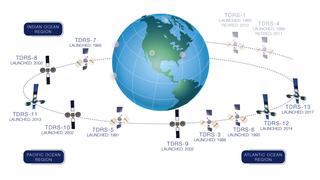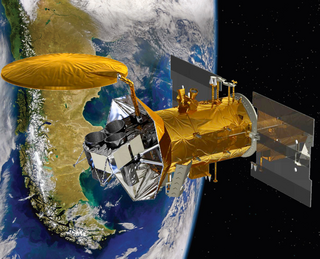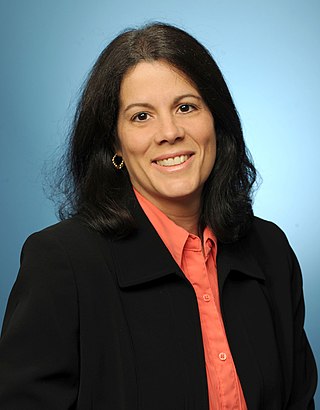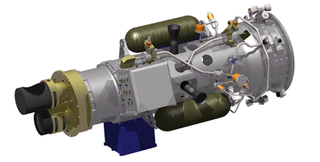Related Research Articles
Project Vanguard was a program managed by the United States Navy Naval Research Laboratory (NRL), which intended to launch the first artificial satellite into low Earth orbit using a Vanguard rocket as the launch vehicle from Cape Canaveral Missile Annex, Florida.

The Goddard Space Flight Center (GSFC) is a major NASA space research laboratory located approximately 6.5 miles (10.5 km) northeast of Washington, D.C., in Greenbelt, Maryland, United States. Established on May 1, 1959, as NASA's first space flight center, GSFC employs about 10,000 civil servants and contractors. Named for American rocket propulsion pioneer Robert H. Goddard, it is one of ten major NASA field centers. GSFC is partially within the former Goddard census-designated place; it has a Greenbelt mailing address.

The U.S. Tracking and Data Relay Satellite System is a network of American communications satellites and ground stations used by NASA for space communications. The system was designed to replace an existing network of ground stations that had supported all of NASA's crewed flight missions. The prime design goal was to increase the time spacecraft were in communication with the ground and improve the amount of data that could be transferred. Many Tracking and Data Relay Satellites were launched in the 1980s and 1990s with the Space Shuttle and made use of the Inertial Upper Stage, a two-stage solid rocket booster developed for the shuttle. Other TDRS were launched by Atlas IIa and Atlas V rockets.

The Solar Orbiter (SolO) is a Sun-observing probe developed by the European Space Agency (ESA) with a National Aeronautics and Space Administration (NASA) contribution. Solar Orbiter, designed to obtain detailed measurements of the inner heliosphere and the nascent solar wind, will also perform close observations of the polar regions of the Sun which is difficult to do from Earth. These observations are important in investigating how the Sun creates and controls its heliosphere.

A tracking and data relay satellite (TDRS) is a type of communications satellite that forms part of the Tracking and Data Relay Satellite System (TDRSS) used by NASA and other United States government agencies for communications to and from independent "User Platforms" such as satellites, balloons, aircraft, the International Space Station, and remote bases like the Amundsen-Scott South Pole Station. This system was designed to replace an existing worldwide network of ground stations that had supported all of NASA's crewed flight missions and uncrewed satellites in low-Earth orbits. The primary system design goal was to increase the amount of time that these spacecraft were in communication with the ground and improve the amount of data that could be transferred. These TDRSS satellites are all designed and built to be launched to and function in geosynchronous orbit, 35,786 km (22,236 mi) above the surface of the Earth.

The Spacecraft Tracking and Data (Acquisition) Network was established by NASA in the early 1960s to satisfy the requirement for long-duration, highly available space-to-ground communications. The network was the "follow-on" to the earlier Minitrack, which tracked the flights of Sputnik, Vanguard, Explorer, and other early space efforts (1957–1962). Real-time operational control and scheduling of the network was provided by the Network Operations Control Center (NOCC) at the Goddard Space Flight Center (GSFC) in Greenbelt, Maryland.

Metop is a series of three polar-orbiting meteorological satellites developed by the European Space Agency (ESA) and operated by the European Organisation for the Exploitation of Meteorological Satellites (EUMETSAT). The satellites form the space segment component of the overall EUMETSAT Polar System (EPS), which in turn is the European half of the EUMETSAT / NOAA Initial Joint Polar System (IJPS). The satellites carry a payload comprising 11 scientific instruments and two which support Cospas-Sarsat Search and Rescue services. In order to provide data continuity between Metop and NOAA Polar Operational Environmental Satellites (POES), several instruments are carried on both fleets of satellites.

Aquarius was a NASA instrument aboard the Argentine SAC-D spacecraft. Its mission was to measure global sea surface salinity to better predict future climate conditions.

Amri Hernández-Pellerano is a Puerto Rican electronics engineer and scientist who designs, builds and tests the electronics that will regulate the solar array power in order to charge the spacecraft battery and distribute power to the different loads or users inside various spacecraft at NASA's Goddard Space Flight Center. She designed the power systems electronics for the Wilkinson Microwave Anisotropy Probe (WMAP) mission. WMAP is a NASA Explorer mission spacecraft which measures the temperature of the cosmic background radiation over the full sky with unprecedented accuracy.

Landsat 8 is an American Earth observation satellite launched on 11 February 2013. It is the eighth satellite in the Landsat program; the seventh to reach orbit successfully. Originally called the Landsat Data Continuity Mission (LDCM), it is a collaboration between NASA and the United States Geological Survey (USGS). NASA Goddard Space Flight Center in Greenbelt, Maryland, provided development, mission systems engineering, and acquisition of the launch vehicle while the USGS provided for development of the ground systems and will conduct on-going mission operations. It comprises the camera of the Operational Land Imager (OLI) and the Thermal Infrared Sensor (TIRS), which can be used to study Earth surface temperature and is used to study global warming.

XSS-10 was a small, low-cost micro-spacecraft developed by the U.S. Air Force Research Laboratory's Space Vehicles Directorate to test technology for line-of-sight guidance of spacecraft. The project was initiated at AFRL by Program Manager David Barnhart and completed by Georgia Tech Research Institute engineer Thom Davis and team. The project was declared a success shortly after launch.
Space Network (SN) is a NASA program that combines space and ground elements to support spacecraft communications in Earth vicinity. The SN Project Office at Goddard Space Flight Center (GSFC) manages the SN, which consists of:

The NASA (Ground) Communications System (NASCOM) manages terrestrial communications between ground stations, mission control centers, and other elements of spacecraft ground segments. Established in 1964, NASCOM provides worldwide, near real-time, transmission of commands, telemetry, voice, and television signals. It is managed out of NASA's Goddard Space Flight Center in Greenbelt, Maryland.
The Global Educational Network for Satellite Operations (GENSO) is forming by a worldwide network of ground stations and spacecraft which can interact via a software standard. The GENSO aims to increase the return from educational space missions and changed the way that these missions are managed, dramatically increasing the level of access to orbital educational spacecraft.

A ground segment consists of all the ground-based elements of a space system used by operators and support personnel, as opposed to the space segment and user segment. The ground segment enables management of a spacecraft, and distribution of payload data and telemetry among interested parties on the ground. The primary elements of a ground segment are:

Lunar Flashlight was a low-cost CubeSat lunar orbiter mission to explore, locate, and estimate size and composition of water ice deposits on the Moon for future exploitation by robots or humans.

Lunar IceCube is a NASA nanosatellite orbiter mission that was intended to prospect, locate, and estimate amount and composition of water ice deposits on the Moon for future exploitation. It was launched as a secondary payload mission on Artemis 1, the first flight of the Space Launch System (SLS), on 16 November 2022. As of February 2023 it is unknown whether NASA team has contact with satellite or not.

XTCE is an XML based data exchange format for spacecraft telemetry and command meta-data. Using XTCE the format and content of a space systems command and telemetry links can be readily exchanged between spacecraft operators and manufacturers. XTCE was originally standardized by the OMG. In April 2007 the OMG released revision 1.1 of XTCE as an OMG available specification. Version 1.0 of the XTCE specification is a CCSDS green-book specification and version 1.1 has been adopted as a CCSDS blue-book specification.

Nimbus 4 was a meteorological satellite. It was the fourth in a series of the Nimbus program.

Hera is a spacecraft developed by the European Space Agency for its space safety program. Its primary mission objective is to study the Didymos binary asteroid system that was impacted four years earlier by the NASA Double Asteroid Redirection Test (DART) spacecraft and contribute to validation of the kinetic impact method to deviate a near-Earth asteroid from a colliding trajectory with Earth. It will measure the size and morphology of the crater created as well as the momentum transferred by an artificial projectile impacting an asteroid, which will allow measuring the efficiency of the deflection produced by the impact. It will also analyze the expanding debris cloud caused by the impact.
References
- ↑ Desjardins, R., et al. "GSFC Systems Test and Operation Language (STOL) Functional Requirements and Language Description", NASA, report number NASA-TM-79541 X-408-77-100, 1 February 1978.
- ↑ Desjardins, R., et al., 1978, p. 1-1.
- ↑ Desjardins, et al., 1978, p. iii, "STOL represents the synthesis of several independent language developments at GSFC, notably the Procedure Control Language (PCL) family, the Orbiting Solar Observatory/atmosphere Explorer (OSO/AE) language family and the Applications Technology Satellite/High Energy Astronomy Observatory (ATS/HEAO) language family."
- ↑ Page, Brenda J. "An English language interface for constrained domains", conference paper; NASA, Goddard Space Flight Center, The 1989 Goddard Conference on Space Applications of Artificial Intelligencel 1 April 1989, p 21-34.
- 1 2 Operations and Information Systems Group. "OASIS-CC Presentation", The Fifth Calibration/Data Product Validation Panel Meeting, NASA Goddard Space Flight Center, 1 January 1992, PDF p. 10.
- ↑ Spacecraft commands may be uplinked in text format, if the receiving spacecraft can translate them. Otherwise, the ground system translates the text format to a binary format before uplink. As noted above, in some systems spacecraft can accept command language statements as well, and perform their own translation. The translated commands are probably hexadecimal (the source document doesn't say). Note that in the first and last pairs of commands, different natural-language units are used in the command pairs on the left, that translate into identical binary fields in the commands on the right. "1800" may be an instrument-specific raw command parameter value.
- ↑ Field, Thomas C., submitter, "Geoscience Laser Altimeter System Integration and Test Plan", NASA GSFC GLAS CMO, document GLAS-568-PLAN-001, 22 March 1999, acronym list p. 1, PDF p. 81. Retrieved 12 June 2019.
- ↑ Melton, B. et al. "ESA's ETOL Software in International Markets", European Space Agency (ESA), ESA Bulletin no. 85, February 1996, archived at The Wayback Machine. Retrieved 12 June 2019.
- ↑ Page, B., 1989.
- ↑ Estlin, Tara; Jonsson, Ari; Pasareanu, Corina; Simmons, Reid; Tso, Kam; Verma, Vandi. "Plan Execution Interchange Language (PLEXIL)" (PDF). NASA Technical Reports Server. Retrieved 17 June 2019.
- ↑ Seymour, Mark A. "The PLUTO operations procedure language and its use for RADARSAT-2 mission operations.", AIAA Space OPS 2004 Conference, 17 May 2004.
- ↑ Desjardins, et al., 1978.
- ↑ Brown, et al., "Timeliner: Automating Procedures on the ISS", Draper Lab, NASA-JSC, conference paper, World Space Conference, Houston, Texas, 09 October 2002.
- 1 2 Draper Laboratory, "Draper Lab Brings A New Age of Automation to the International Space Station", press release, 11 October 2002.
- ↑ Measday, Alex. "TPOCC Systems Test and Operations Language (TSTOL), 1993, and Background, 2016", Alex Measday's blog, 1993 and 2016. Retrieved 12 June 2019.
- ↑ Sepan, David M. and Lawrence, George B."", AIAA SPACE 2010 Conference & Exposition, Anaheim, Calif., 30 Aug 2010, AIAA-2010-8760. Retrieved on 12 June 2019 from author's publications folder, "Sepan_Lawrence.2010.pdf", p. 2.
- ↑ Mims, Tikiela L., "Use of Spacecraft Command Language for Advanced Command and Control Applications", NASA KSC Technical Report number KSC-2008-288, 21 September 2008, p. 1.
- ↑ Interface Control Systems (archived). "What is SCL", company web page, archived at The Wayback Machine, captured 10 March 2009. Retrieved on 17 June 2019.
- ↑ Software Control Solutions. "Spacecraft Command Language (SCL)", company web page. Retrieved 17 June 2019.
- ↑ "Cable Broadband Industry Leaders Address Auspice TLX Users Conference", news item, Business Wire, 31 March 2004.
- ↑ Two Auspice corporate websites, "auspiceinc.com" and "auspicecorp.com, now redirect to "Arris Corp.", which acquired Auspice in 2008 and which might only retain Auspice as an item in a list of trademarks at the bottom of datasheets for their other products (searched arris.com in July 2019).